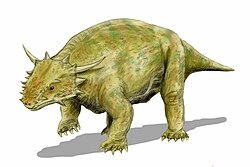| Obirkovia Temporal range: Late Permian | |
|---|---|
| Scientific classification | |
| Domain: | Eukaryota |
| Kingdom: | Animalia |
| Phylum: | Chordata |
| Clade: | † Parareptilia |
| Order: | † Procolophonomorpha |
| Clade: | † Pareiasauria |
| Clade: | † Elginiidae |
| Genus: | † Obirkovia |
| Species: | †O. gladiator |
| Binomial name | |
| †Obirkovia gladiator Bulanov & Yashina, 2005 | |
Obirkovia is an extinct genus of pareiasaur from the late Permian Salarevo Formation of Russia. The genus contains a single species, O. gladiator, known from a left quadratojugal.

